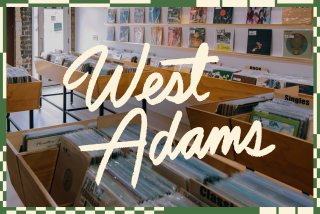Monument to Past in Glendale : Doctors’ House: Fit as Fiddle at 100
- Share via
It was a celebration marking the 100th birthday of Doctors’ House, a Victorian-style mansion that is one of few remaining symbols of the late 19th-Century era in Glendale.
About 500 people, many dressed in period costumes, attended the event sponsored by the Glendale Historical Society.
Antique vehicles, including a 1915 Model T Ford, a 1908 Reo and a replica of an 1880s-style Penny Farthing bicycle were on display on the lawn of the mansion, now in Brand Park. Docents led visitors on tours through the house as they were entertained by music from a 1905 record player.
Ice cream, popcorn and lemonade enhanced the old-fashioned atmosphere at the Sunday afternoon celebration.
Doctors’ House, built in 1888, originally was at 921 E. Wilson Ave. It was so named because at least four doctors lived there during the early days of its existence. However, nobody is quite sure of the name of the original owner, although history buffs think that the home was built by a Dr. Bogue.
In 1906, Dr. Leon H. Hurtt, first president of the Glendale Chamber of Commerce, bought the mansion. The home then was described as a showcase that contained “acres of lemon and orange groves, a fig patch, rosebushes everywhere and shrubbery and pepper trees.”
Unique Style
In later years, the home’s architectural style was found to be unique in the Glendale community as older structures began to disappear, victims of modern housing developments.
Doctors’ House represents design characteristics of the Queen Anne Eastlake style that was popular in the 1880s.
It is tall with a high, steep roof, has latticework on the porch and veranda and a complex and irregular silhouette.
The 2-story, blue-and-white mansion was moved to Brand Park in 1980 after several Glendale residents convinced the city that the building should not be torn down to make way for a condominium development.
The historical society paid for the move with a $30,000 loan, which it repaid by 1984. The city donated vacant property in the park for the house.
The home’s restoration, which took four years, was accomplished with volunteer labor, awards of $80,000 and $90,000 from federal Community Development Block Grant funds, and another $40,000 raised by the society and through donations from the community.
More to Read
Sign up for Essential California
The most important California stories and recommendations in your inbox every morning.
You may occasionally receive promotional content from the Los Angeles Times.






